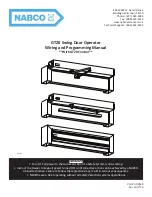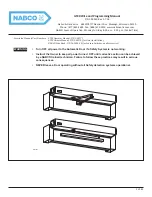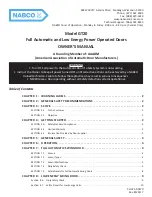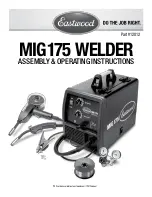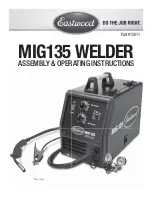
MAINTENANCE /
REP
AIR
TROUBLESHOOTING
OPERA
TION
ASSEMBL
Y /
INST
ALLA
TION
SAFETY /
SPECIFICA
TIONS
GETTING
ST
AR
TED
10
ASSEMBLY INSTRUCTIONS (CONTINUED)
Obtaining Correct Gas Type.
The gas used in any welding application for your welder must be an INERT,
NON-FLAMMABLE TYPE. You can get the type of gas needed from a nearby welding gas distributor (often
found in the yellow pages under “Welders” or “Welding Equipment”).
REGULATOR
The regulator provides a constant shielding gas pressure and flow rate during the welding process. Each
regulator is designed to be used with a specific gas or mixture of gases. The argon and argon mixture use
the same thread type. The 100% carbon dioxide uses a different thread type. An adapter is available at your
local welding gas supplier to change between the two.
HOSE AND REGULATOR HOOKUP PROCEDURE
Cylinder gas is under high pressure. Point cylinder outlet away from yourself and any
bystanders before opening.
1. With cylinder securely supported, stand on side of cylinder opposite cylinder outlet then remove
cylinder cap and open valve
slightly
by turning counterclockwise. When gas is emitted from cylinder,
close valve by turning clockwise. This will blow out dust or dirt that may have accumulated around
valve seat.
2. Install regulator onto cylinder valve. Tighten stem nut securely to gas valve.
3. Install one end of gas hose to fitting on the back of welder and other end of hose to fitting on
regulator. Make sure gas hose is not kinked or twisted.
4. While standing opposite cylinder outlet, slowly open cylinder valve. Inspect for leaks in the connections.
5. Remember to close gas cylinder valve when finished welding.
OPERATING INSTRUCTIONS
1. Be sure to read, understand and comply with all precautions in the General Safety Instructions section.
Be sure to read entire “Welding Guidelines” section before using this equipment.
2. Turn welder off.
3. Verify surfaces of metals to be joined are free from dirt, rust, paint, oil, scale or other contaminants.
These contaminants make welding difficult and cause poor welds.
All persons operating this equipment or in the area while equipment is in use must wear
protective welding gear including: eye protection with proper shade 10, flame resistant
clothing, leather welding gloves and full foot protection.
If heating, welding or cutting galvanized, zinc plated, lead, or cadmium plated materials, refer
to the General Safety Instructions Section for instructions. Extremely toxic fumes are created
when these metals are heated.
4. Connect work clamp to work piece or workbench (if metal). Make sure contact is secure. Avoid surfaces
with paint, varnish, corrosion or non-metallic materials.
5. Rotate Wire Speed Control to setting per decal inside wire feed compartment, then adjust as needed
after test.
6. Plug power cord into a proper voltage receptacle with proper circuit capacity (see circuit requirements
on Page 6).
7. Switch welder on to desired heat setting per decal inside wire feed compartment, then adjust as
needed after test.
NOTE:
These settings are general guidelines only. Heat setting may vary according to welding conditions
and materials.
8. Verify wire is extended 1/4 inch from contact tip. If not, squeeze trigger to feed additional wire, release
trigger, turn welder off, and cut wire to proper length. Then, switch back on to desired heat setting.
9. Position torch near work piece, lower welding helmet by nodding head or positioning the hand shield,
and squeeze torch trigger. Adjust heat setting and wire speed as needed.
10. When finished welding, turn welder off and store properly.
MANUAL






























